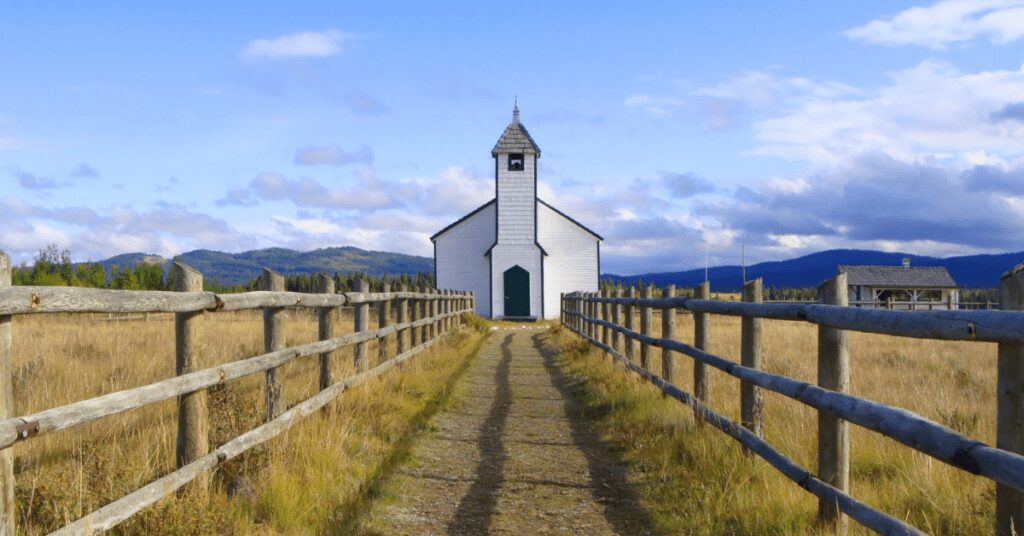By Mark Elsdon, M.Div, MBA.
With parts adapted from We Aren’t Broke: Uncovering Hidden Resources for Mission and Ministry by Mark Elsdon ©2021 (Wm. B. Eerdmans Publishing Co.) Reprinted by permission of the publisher.
As I write about in my new book, “We Aren’t Broke,” Christian churches in the United States own billions of dollars of invested assets and some of the most valuable property in the nation. These sometimes “hidden” assets have potential to transform lives and neighborhoods for good and to unlock and fund new expressions of church. But we must be honest with ourselves that this enormous wealth didn’t appear out of thin air or just through the gifts of faithful saints. In many denominations, institutions, and churches, their wealth was made possible by two key stolen inputs: land and people. Land was stolen from indigenous people, and people were stolen from their land.
The legacy of slavery and stolen land is embedded in the very fabric of our economic system in the United States. Much of the wealth of our nation has roots in money made on the backs of people who were enslaved on land taken from indigenous peoples. And church institutions are just as bound up in this reality as any other part of our society. Historically white church institutions own huge endowments and incredibly valuable property while Black and indigenous churches often have very little generational wealth to draw upon.
The campus church where I serve as Executive Director, Pres House, is built on the traditional, ancestral homelands of the Ho-Chunk, who lived in the Madison Wisconsin (Four Lakes) area long before Europeans colonized the area. Virginia Theological Seminary and Princeton Theological Seminary (my alma mater) have both recently completed studies of their historic ties to slavery. Princeton Seminary currently has a $1 billion endowment. The source of this wealth is intimately tied to the enslavement of people.
In the nineteenth century, donations to the seminary came from slaveholding individuals and congregations. For a period of time, the early seminary endowment was invested in Southern banks that were financing the expansion of slavery. As much as 30 to 40 percent of the seminary’s pre–Civil War income can be traced to slavery. The first three professors of the seminary all used slave labor at some point in their lives—in some cases while teaching at the seminary. The upstream source of the seminary’s current wealth is filthy and polluted.
“So what?” some might ask. That was a long time ago. Church institutions reject slavery today and many use the income from their endowments to seek justice and serve their neighbors. The money made from slavery generations ago is now being put to good use isn’t it?? Isn’t the good that they are doing with the money enough to “clean” up the sordid history of where that money came from?
Perhaps. Certainly putting “dirty” money to work for good in the world is preferable to continuing to use it for harm. But is it enough? I am not convinced it is. As Ta-Nehisi Coates bluntly states in “The Case for Reparations” published in The Atlantic, “America was built on the preferential treatment of white people—395 years of it. Vaguely endorsing a cuddly, feel-good diversity does very little to redress this.” To more appropriately address the injustices of the past, church institutions need to put the proceeds of that tainted money to work in ways that directly create a new form of justice today. Investing capital and using property differently could be one form of reparations.
Reparations is the idea of making amends for a wrong that has been committed. Reparations is an attempt to restore justice and often involves paying money to those who have been wronged. There are many ways that churches can think about reparations but I offer two suggestions here that relate specifically to the billions of dollars of invested assets and property that many of our church institutions (we) own:
- Invest differently: Edgar Villanueva, in his book Decolonizing Wealth, calls upon foundations throughout the country to voluntarily set aside 10 percent of their assets to create a fund from which indigenous people and African Americans could receive grants that would help create wealth and restore justice through funding for home ownership and start-up businesses. What if church institutions took the lead on this?! Imagine if every church owned investment portfolio moved 10% (or more) of its assets into impact investments that invest in Black-owned businesses or Black-led social enterprises. Instead of investing in Apple, Facebook, and Amazon, church money would become an empowering investment in job creation, community development, and wealth creation for those who have largely missed wealth growth.
This would be a good first step; an even better one would be to transfer ownership of invested assets from historically white-led institutions to institutions owned or led by people of color. This form of reparation would begin to move the needle toward justice. (See my previous article for more on impact investing.)
- Transfer the ownership of property: There is a massive transfer of property value happening in the American church now and in the next 5-10 years. Church properties are being sold at a rapidly increasing rate each year. What is happening to the value of those properties? Much of the time, when a church property is sold, the income is used to perpetuate a slowly dwindling church institutional structure. Or funds are handed out in small grants to various local charities. Neither of those options is inherently bad. But what if the proceeds from the sale of churches are given away or invested more intentionally in a manner consistent with reparations or as I described above? Or what if the majority white institution owning the property doesn’t sell it all but gives it away (back) to people in the neighborhood.
I have seen dynamic leaders of color building new churches, creating social enterprises, and transforming their neighborhoods – but who have no access to good property. Meanwhile valuable churches owned by predominantly white churches sit empty nearby or fall into disrepair. Let’s give those properties to leaders of colors and/or pass ownership to the neighborhood. Let’s not just rent the property out to communities of color, “diversify” a historically white-church by hosting them in “white” space, or even let them use a property rent free – but let’s give it to them to own. Transferring ownership, control, and wealth is an essential component of any meaningful act of reparation.
Giving up “ownership” and control is not easy. But much of the wealth contained in investments and property within the church was sinfully stolen. It is long past time for meaningful reparations. White individuals and historically white institutions must be willing to invest in businesses, neighborhoods, and social enterprises that are owned and led by people of color. And to do so in such a way that ownership accrues to those who have for centuries created, but not benefited from, wealth. Done correctly, property and economic development using impact investing as fuel has the potential to shift wealth back from the descendants of slaveholders to the descendants of slaves. It is time to invest differently in the future in order to begin to repair the past.

